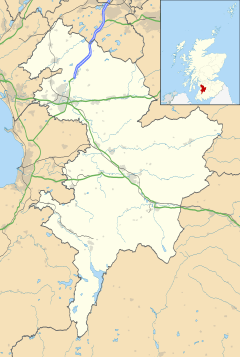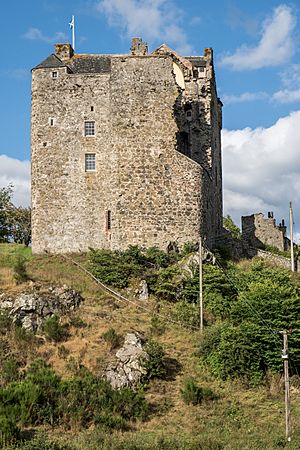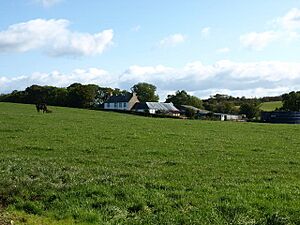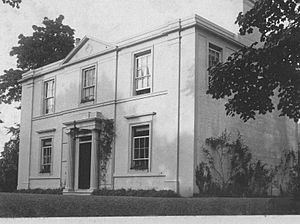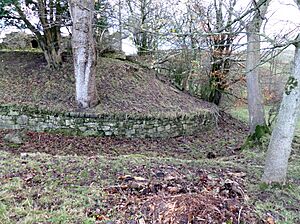Lands of Dallars facts for kids
Quick facts for kids Lands of Dallars
|
|
|---|---|
| OS grid reference | NS403488 |
| Council area | |
| Lieutenancy area | |
| Country | Scotland |
| Sovereign state | United Kingdom |
| Post town | Kilmarnock |
| Police | Strathclyde |
| Fire | Strathclyde |
| Ambulance | Scottish |
| EU Parliament | Scotland |
The Lands of Dallars or Auchenskeith is a small estate in East Ayrshire, Hurlford, Kilmarnock, Parish of Riccarton, Scotland. The main house you see today was built in the late 1700s. It sits by the Cessnock Water, where older buildings once stood.
The name of the estate has changed many times. It started as "Dullers" or "Dillers." Then it became "Auchenskeith" or "Auchinskeigh." Later, it went back to "Dollars" and finally "Dallars." Dallars is about 3.25 kilometers (2 miles) south of Hurlford.
Contents
A Look Back at Dallars
The Dallars estate is located on what used to be the northern edge of Cunninghame. This area borders lands owned by the Campbells of Loudoun and the Wallaces.
The Main House and Estate Buildings
The main house at Dallars was built on a small hill. This spot offered great views of the area. Originally, there might have been a strong, fortified building here, like a tower house. The current mansion house is a "Category B Listed Building." This means it's an important historical building.
A garden shed at the walled garden has the year 1779 carved into it. This is when the main house was finished. The mansion has three floors. The front porch might have been added later. The parts sticking out on the sides were added during the Victorian era.
The estate also had other buildings. These included stables, some of which date back to around 1635. There was also Mains Farm, a dovecot (a home for pigeons), and a walled garden. The garden walls were made of brick with fancy stone pillars.
The landscape around the estate has changed over time. In the 1700s and 1800s, it started with tree-lined parks. Over the years, it became a more natural and less formal landscape.
The estate's name changed to 'Auchenskeith' for a while. This happened after it was bought by someone who also owned the Auchenskeith estate near Dalry in North Ayrshire.
Who Owned Dallars?
One of the first known owners of "Dullers" was Archibald Dunlop. He married a woman from the Craufurdland family.
In 1712, William Cunningham officially took ownership of the lands of Auchinskeith. He passed away in 1727. A special bell called a "Dead bell" was used to announce a death. It was rung during funeral processions. The Kilmarnock funeral bell from 1639 was still remembered in the 1850s. William's heir paid money to use it in 1727.
Another William Cunningham of Auchenskeith inherited the estate. He became a "burgess" of Ayr in 1738. A burgess was a citizen with special rights in a town.
In 1764, William Cunningham and his son, also named William, owned many lands around Kilmarnock, Riccarton, and Hurlford. These lands had been held by Hugh, Earl of Marchmont.
Captain William Cuningham owned the lands in the late 1760s. He traveled to St Kitts in the West Indies. There, he met and married Agnes Colquhoun in 1770. Agnes was the daughter of a plantation manager. Records show that a John Begbie worked as a servant for Captain William Cuningham in 1777-78.
In 1767, William Cuningham of Auchenskeith sold some lands called Langlands to Dr. Park.
Alexander Cuningham, William's second son, became an Ayr burgess in 1775.
By 1803, Quintin MacAdam was the owner of Dallars. After he died in 1805, Sir William Cuningham became a trustee of the estate. The property was then rented out.
In 1847, Honoria Mary MacAdam, the daughter of Colonel William MacAdam, married Edward Carleton Tufnell. They lived at Dallars. Edward was a strong supporter of colleges that trained teachers. He also worked in London from 1835 to 1846, helping with laws for the poor.
Their son, Carleton Tufnell, was born in 1848. He became a retired Royal Navy Commander. In 1878, he married a daughter of the 1st Viscount Anson.
In 1885, Lady Adelaide Hastings lived at Dallars. At this time, the estate was owned by the Honourable Jean MacAdam Cathcart.
The Richards family bought Dallars in 1962.
Auchenskeith, Dalry
The name 'Achin-skyich' was recorded by Timothy Pont. It comes from the Scots Gaelic words "Achad-na-sgitheach." This means "Field of thorns." These lands were first part of the Blair estates. However, the Dunlops of that Ilk owned them for 300 years. Auchenskeith later went to the Cuninghams of Robertland. In 1818, Sir William Cuningham sold the Auchenskeith estate to Colonel William Blair.
Robert Burns and Dallars
The famous Scottish poet, Robert Burns, visited the area sometimes. His home, Lochlea Farm, was only two miles away. It's said that Auchenskeith was in Burns's mind when he wrote a line in his poem "The Vision."
Sir William Cuningham's teacher was Rev. James McKinlay. He was a minister in Kilmarnock and appears in Burns's poem "The Ordination." In 1789, Burns asked Captain Robert Riddell to send a letter to Sir William Cuningham. A "Lady 'C'" mentioned in a letter from Burns in 1786 might have been Lady Cuningham.
Sir William Cuningham of Auchenskeith and Robertland also owned Robertland House. He got it through his marriage to Margaret Fairlie. He invited Robert Burns to Robertland. Robert Burnes, the poet's uncle, worked as a Land Steward for the Robertland estate.
Alison Begbie is believed to have been proposed to by Robert Burns. She was a farmer's daughter and worked as a servant at Carnell House. This house was also near the Cessnock Water. Alison Begbie might have grown up at 'Old Place,' close to Shawsmill Farm. Burns was living at Lochlea Farm at that time.
Alison met Burns in 1781 near Lochlea Farm. It's interesting that a John Begbie was a servant to Captain William Cuningham in 1777-78.
Lady Sophia Rawdon-Hastings
In 1845, Lady Sophia Rawdon-Hastings married the Second Marquess of Bute. She was the daughter of the Marquess of Hastings. Sadly, her husband died, leaving her with a six-month-old son. This son would later become the Third Marquess, John Patrick Crichton Stuart.
The 2nd Marquess's brother, Lord James, did not allow Lady Sophia and her son to use Dumfries House or Mount Stuart. So, Lady Sophia rented Dallars House, which was near Loudoun Castle. They lived at Dallars between 1849 and 1853. After that, they moved to Mount Stuart. She also rented Largo House for the summer months. In 1855-57, the Marchioness of Bute was still renting Dallars. Her sister, Lady Adelaide Hastings, was living there.
Nature at Dallars
The Dallars estate has a very old and large Spanish Chestnut tree. People say it was planted by William and Agnes Cuningham. The walled garden also has a rare plant called Mistletoe growing on an apple tree.
Old Maps and Names
Old maps help us understand the history of Dallars.
- A 1662 map by Joan Blaeu shows the name as 'Dullers.' It also shows a fence around the house and some woods.
- In 1732, the site is still called "Dullers."
- The 1747 map by William Roy calls it "Dillars." It also shows Dillars Shaw and Shaws Mill.
- In 1775, Andrew Armstrong's map shows "Auchenskeigh" for the first time.
- Ainslie's map in 1821 shows the name "Auchenskaith."
- Taylor and Skinner's map from 1776 shows 'Auchenskeich' as Captain Cuningham's property. It shows a mansion house, even before the main part of the current building was finished in 1779.
- By 1828, the name "Dallars" replaced the Auchenskeith variations.
- The 1855-57 Ordnance Survey Book recorded the name as Dollars.
What's in a Name?
There's a story about why the name 'Auchenskeith' changed to 'Dollars.' It's said that Captain William Cuningham received a large dowry (money or property given by a bride's family) from Robert Colquhoun when he married Agnes. Robert was a plantation owner in the West Indies, where the currency was the 'Dollar.' This money was supposedly used to build the original house.
However, the name Dullers was recorded in the 1660s. This was long before William Cuningham married Agnes Colquhoun in 1770. So, the story might not be entirely true. The name Dallars might come from Welsh words: dol meaning 'meadow' and ar meaning 'ploughed land.' This is similar to the name 'Dollar' near Alloa.
The name was changed to 'Auchenskeith' after it was bought by the owner of another Auchenskeith estate near Dalry. In 1855-57, the official name was recorded as "Dollars."
Nearby Places
In 1855-57, Shaw's Mill (a corn mill) was owned by the Duke of Portland. William Woodburn was the miller.
'Old Place,' to the east, was once the home of the Campbells of Cessnock. They later built Cessnock Castle. Old Place became part of the Shawmill lands and was eventually left empty. Later maps don't show 'Old Place' anymore.
Old Roads and Bridges
The 1854-59 map shows that a bridge called Aird bridge once crossed the Cessnock Water. A house, Aird Bridgend, stood on the west side. A road went from the main road, over the bridge, and up to Aird Farm. Another road led to the main road near Snodston Farm.
A Local Story
John Galloway, who owned Barleith and Dollars coal mines, built a special center in New Street Riccarton. It was for the working men in the area. This building is still there today and is used as a Community Centre by East Ayrshire Council.
See also


